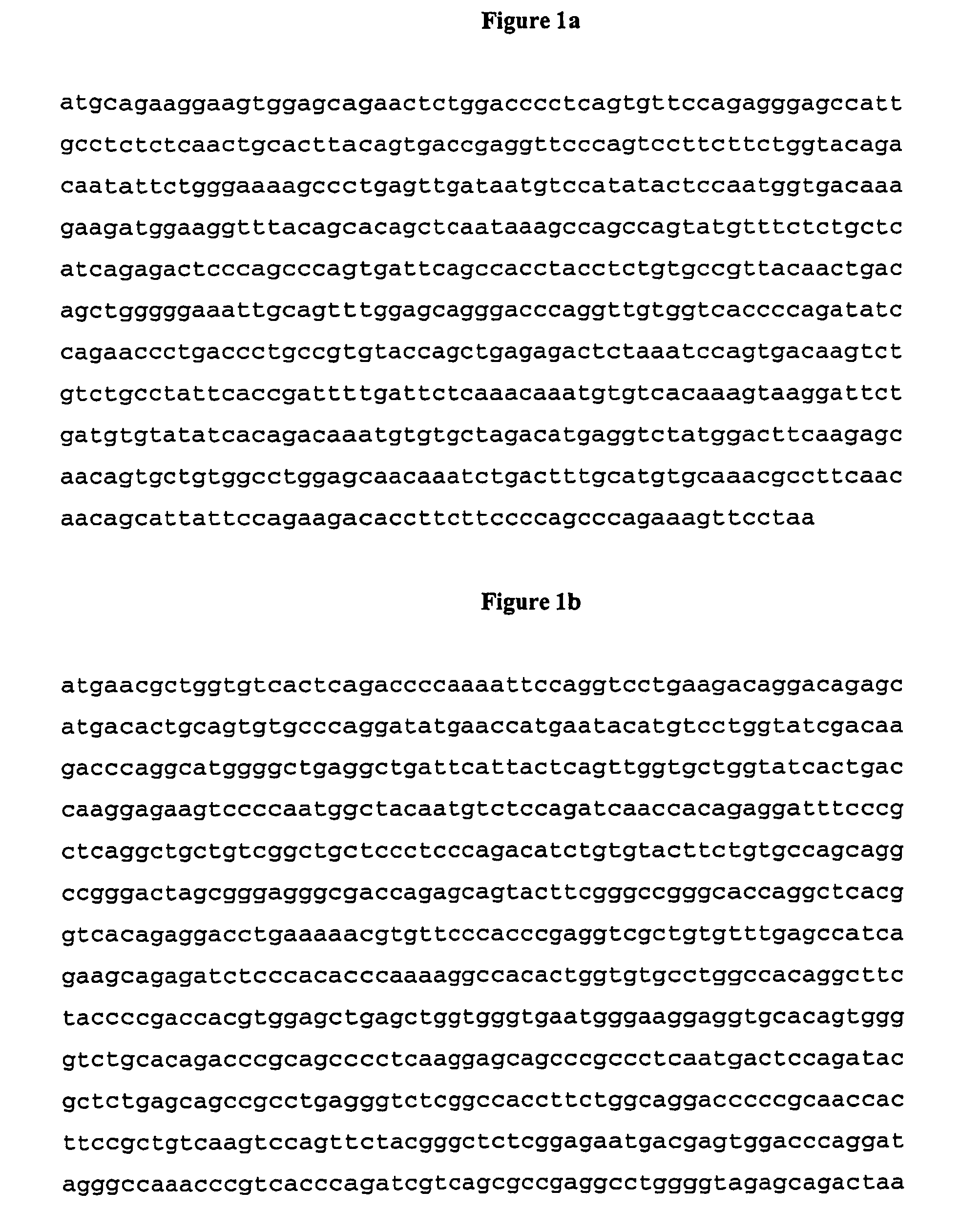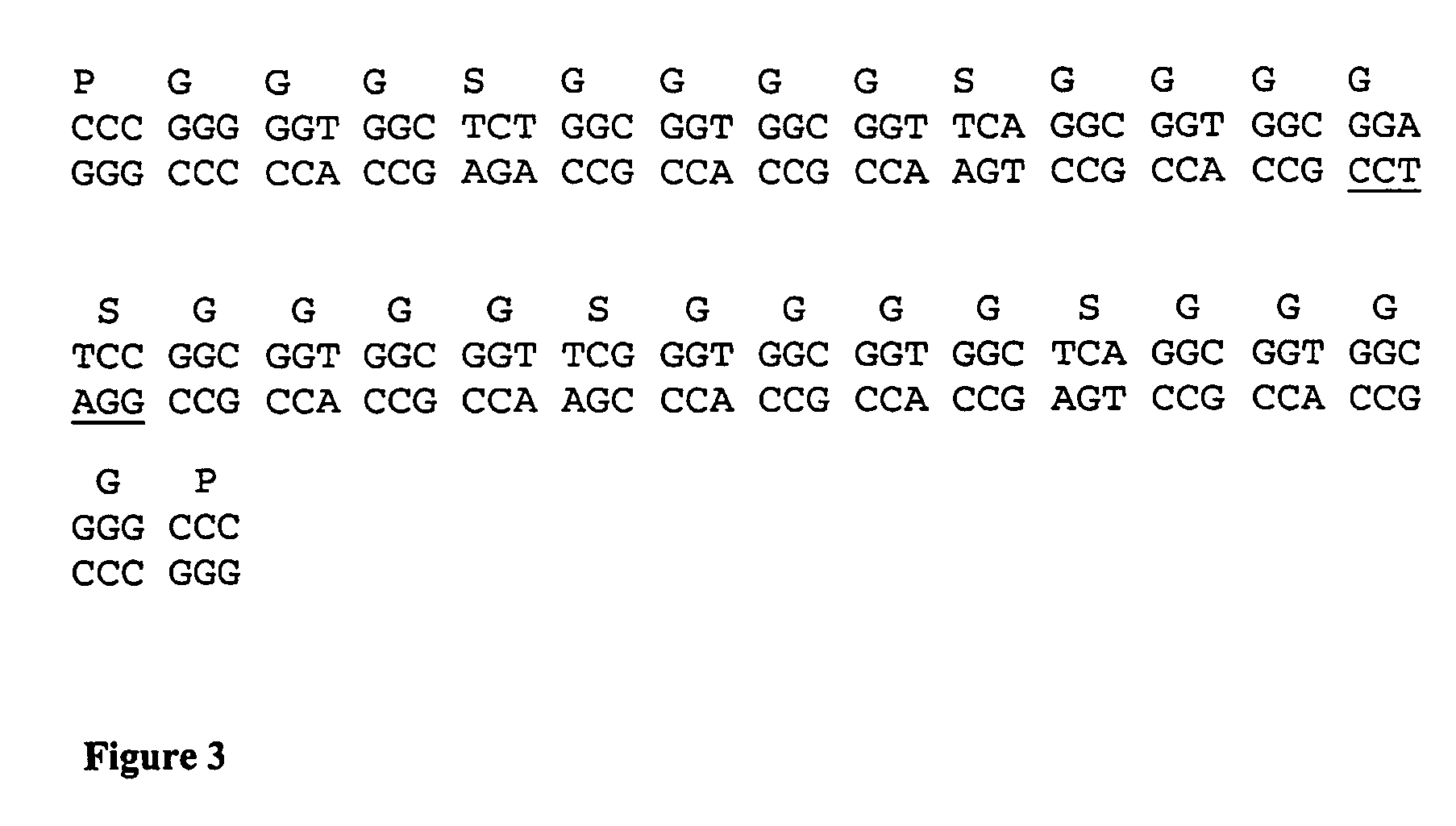Single chain recombinant T cell receptors
a single-chain recombinant and receptor technology, applied in the field of single-chain recombinant t cell receptors, can solve the problems of inability to produce functional alpha/beta analogue sctcrs by simply linking alpha and beta chains such that both are expressed in a single open reading frame, and the limitations of screening programmes most often reside in natur
- Summary
- Abstract
- Description
- Claims
- Application Information
AI Technical Summary
Benefits of technology
Problems solved by technology
Method used
Image
Examples
example 1
Design of Primers and Mutagenesis of A6 Tax TCR α and β Chains to Introduce the Cysteine Residues Required for the Formation of a Novel Inter-chain Disulphide Bond
[0097]For mutating A6 Tax threonine 48 of exon 1 in TRAC*01 to cysteine, the following primers were designed (mutation shown in lower case):
[0098]
(SEQ ID NO:22)5′-C ACA GAC AAA tgT GTG CTA GAC AT(SEQ ID NO:23)5′-AT GTC TAG GAG Aca TTT GTC TGT G
[0099]For mutating A6 Tax serine 57 of exon 1 in both TRBC1*01 and TRBC2*01 to cysteine, the following primers were designed (mutation shown in lower case):
[0100]
(SEQ ID NO:24)5′-C AGT GGG GTC tGC ACA GAC CC(SEQ ID NO:25)5′-GG GTC TGT GCa GAC CCC ACT G
PCR Mutagenesis:
[0101]Expression plasmids containing the genes for the A6 Tax TCR α or β chain were mutated using the α-chain primers or the β-chain primers respectively, as follows. 100 ng of plasmid was mixed with 5 μl 10 mM dNTP, 25 μl 10×Pfu-buffer (Stratagene), 10 units Pfu polymerase (Stratagene) and the final volume was adjusted ...
example 2
Design, Expression and Testing of a Single-chain A6 TCR Incorporating a Novel Disulphide Inter-chain Bond
[0102]The expression vectors containing the DNA sequences of the mutated A6 TCR α and β chains incorporating the additional cysteine residues required for the formation of a novel disulphide prepared in Example 1 and as shown in FIGS. 1a and 1b were used as the basis for the production of a single-chain A6 TCR, with the exception that the stop codon (TAA) was removed from the end of the a chain sequence, as follows:
[0103]The scDiS A6 TCR contains a 30 amino acid linker sequence between the C-terminus of the TCR α chain and the N-terminus of the β chain. FIG. 3 shows the DNA and amino acid sequence of this linker. The cloning strategy employed to produce the scDiS A6 TCR is summarised in FIG. 4.
[0104]Briefly, the alpha and beta chains of the A6 dsTCR were amplified by PCR using primers containing restriction sites as shown in FIG. 4, i.e.:
[0105]
Alpha 5′ primer:(SEQ ID NO:26)ccaagg...
example 3
BIAcore Surface Plasmon Resonance Characterisation of scTCR Binding to HLA-A2 Tax
[0115]A surface plasmon resonance biosensor (BIAcore 3000™) was used to analyse the binding of the A6 scTCR to its peptide-MHC ligand (HLA-A2 Tax). This was facilitated by producing single pMHC complexes (described below) which were immobilised to a streptavidin-coated binding surface in a semi-oriented fashion, allowing efficient testing of the binding of a soluble T-cell receptor to up to four different pMHC (immobilised on separate flow cells) simultaneously. Manual injection of HLA complex allows the precise level of immobilised class I molecules to be manipulated easily.
[0116]Such immobilised complexes are capable of binding both T-cell receptors and the coreceptor CD8αα, both of which may be injected in the soluble phase.
[0117]Biotinylated class I HLA-A2—Tax complexes were refolded in vitro from bacterially-expressed inclusion bodies containing the constituent subunit proteins and synthetic peptid...
PUM
| Property | Measurement | Unit |
|---|---|---|
| diameter | aaaaa | aaaaa |
| volume | aaaaa | aaaaa |
| volume | aaaaa | aaaaa |
Abstract
Description
Claims
Application Information
 Login to View More
Login to View More - R&D
- Intellectual Property
- Life Sciences
- Materials
- Tech Scout
- Unparalleled Data Quality
- Higher Quality Content
- 60% Fewer Hallucinations
Browse by: Latest US Patents, China's latest patents, Technical Efficacy Thesaurus, Application Domain, Technology Topic, Popular Technical Reports.
© 2025 PatSnap. All rights reserved.Legal|Privacy policy|Modern Slavery Act Transparency Statement|Sitemap|About US| Contact US: help@patsnap.com



